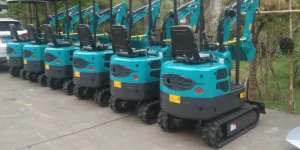Mini excavators are essential tools used across multiple industries, including construction, landscaping, agriculture, utilities, and municipal maintenance. Their compact size, efficiency, and ability to work in confined spaces make them highly valued on modern jobsites. In construction, they offer powerful performance where larger machines can’t fit.
Landscapers appreciate their precision and minimal impact on the ground. Farmers use them for trenching irrigation lines, installing fences, and clearing overgrowth. Utility and government teams rely on them for road maintenance, drainage improvement, and underground pipe installation.
Choosing the right mini excavator depends on a combination of job demands, worksite size, and budget. Key factors include operating weight, dig depth, engine power, fuel efficiency, and ease of use. It’s also important to consider the hydraulic system’s responsiveness and the availability of compatible attachments.
Top models like the Mini Kubota Excavator are known for their reliability, comfort, and smooth control systems. Another great option is the Kymron Mini Excavator, which balances performance with affordability and compact design—ideal for users seeking value without sacrificing capability.
At our company, we specialize in providing Mini Diggers For Sale At Low Prices to meet the needs of professionals in all industries. We offer expert guidance, flexible financing, extended warranty coverage, and responsive after-sales support. Whether you’re a contractor, farmer, or municipality, we help you choose the best machine to increase your efficiency and lower your costs.

How to Operate a Mini Digger?
Before operating a mini digger, inspect the site for hazards and confirm the ground is level. Buckle your seatbelt and start the engine. Use joysticks to control the boom and bucket, and pedals or levers to drive. Always lower the blade for stability. Start with slow, smooth motions to become familiar with the controls. Avoid overreaching or exceeding the arm’s limits. After completing work, shut down safely and perform daily maintenance checks to extend the machine’s life.
Advantages of Using a Mini Excavator
Mini excavators are compact, fuel-efficient, and easy to maneuver, making them ideal for tight worksites. They’re perfect for digging, trenching, grading, and demolition. Thanks to a wide range of attachments, a single machine can handle multiple roles. They’re accessible to beginners, cost-effective to operate, and easy to transport. Their low ground impact also makes them suitable for environmentally sensitive areas.
Step-by-Step Guide: How to Operate a Mini Excavator Safely
1. Inspect the Mini Excavator
Walk around the machine and check for leaks, worn tracks, or loose components. Ensure all safety features are working and fluid levels are adequate.
2. Enter the Cab Safely
Use handrails and steps—never jump in. Once seated, fasten your seatbelt and familiarize yourself with the control layout.
3. Understand the Controls
Most machines use dual joysticks. The left joystick controls the boom and cab swing; the right joystick manages the arm and bucket. Movement is controlled via foot pedals or hand levers.
4. Stabilize with the Blade
Always lower the dozer blade before digging. This provides balance and prevents machine movement during operation.
5. Practice Basic Movements
Start with forward and backward travel, then move to basic digging and turning. Increase speed and complexity as you gain confidence.
6. Use Attachments Properly
Common tools include trenching buckets, hydraulic breakers, and augers. Before using, confirm that all attachment fittings are secure and functioning.
7. Follow Safety Procedures
Wear appropriate PPE, check for buried lines before digging, and avoid working on steep or unstable surfaces. Operate slowly when working near obstacles.
8. Shut Down Safely
Lower all equipment to the ground, return to a level resting position, shut off the ignition, and remove the key. Inspect the machine for wear or issues before leaving.

Excavator Accessories and Versatility
One of the greatest advantages of mini excavators is their adaptability. Their ability to switch between multiple attachments makes them ideal for a wide variety of tasks. Standard digging buckets are used for general excavation and trenching, while grading buckets provide smoother finishes for landscaping and site prep.
Hydraulic breakers make the machine suitable for light demolition work, including concrete or asphalt removal. Augers are ideal for drilling holes for fence posts, trees, or foundations, especially in landscaping and farming.
Specialty attachments like thumbs, grapples, and clamps give operators the ability to lift, grip, and move debris or irregular materials. Rippers help penetrate hard soil or frozen ground. Many modern mini excavators come with quick-coupler systems, making it easy to swap attachments without tools, minimizing downtime and improving productivity.
Engine Power and Hydraulic Performance
A mini excavator’s productivity depends heavily on its engine power and hydraulic performance. The engine drives the machine’s overall force, affecting how quickly and efficiently it can dig, lift, and travel across various surfaces. Higher horsepower improves cycle times and allows the machine to handle more demanding work environments.
Hydraulic systems, meanwhile, power the boom, arm, bucket, and attachments. A smooth, responsive hydraulic system provides better precision and control, which is especially important for trenching, grading, and lifting. Machines like the <strong>Mini Kubota Excavator</strong> are celebrated for balanced engine and hydraulic systems, offering powerful, fuel-efficient operation.
Similarly, the Kymron Mini Excavator delivers robust hydraulic flow with excellent control in compact spaces—ideal for users needing dependable performance at a lower price point.
Key Purchasing Factors for Mini Excavators
Selecting the best mini excavator requires understanding your application and matching it to machine specifications. Consider the operating weight and footprint—smaller units work better in narrow or indoor spaces, while larger units provide greater lifting capacity and reach.
Digging depth and hydraulic flow also influence the machine’s ability to complete tasks efficiently. If you plan to use attachments like breakers or augers frequently, ensure your model has enough hydraulic capacity.
Other considerations include engine emissions compliance, fuel efficiency, operator visibility, cab comfort, and digital control features. Brand reliability and dealer support are crucial—look for well-established names that provide spare parts, warranty coverage, and training.
Options like the Mini Kubota Excavator and Kymron Mini Excavator offer excellent performance, comfort, and support. And with many Mini Diggers For Sale At Low Prices, it’s possible to find a machine that meets both performance needs and budget requirements.
Popular Mini Excavator Models and Use Cases
Mini Kubota Excavator
Known for reliability and efficiency, the Mini Kubota Excavator is ideal for residential construction, landscaping, trenching, and grading. It combines ergonomic controls, strong hydraulics, and fuel economy, making it a top choice for professionals.
Kymron Mini Excavator
Compact yet powerful, the Kymron Mini Excavator is a practical choice for buyers seeking performance and value. With responsive hydraulics and a space-saving design, it’s perfect for road repairs, small-scale construction, and tight-access jobs.
Whether you’re in construction, utilities, agriculture, or municipal work, mini excavators deliver the flexibility and power needed to succeed. Their ability to shift roles using attachments makes them an unbeatable investment.
Mini excavators deliver power, precision, and versatility—all in one compact, affordable machine.





